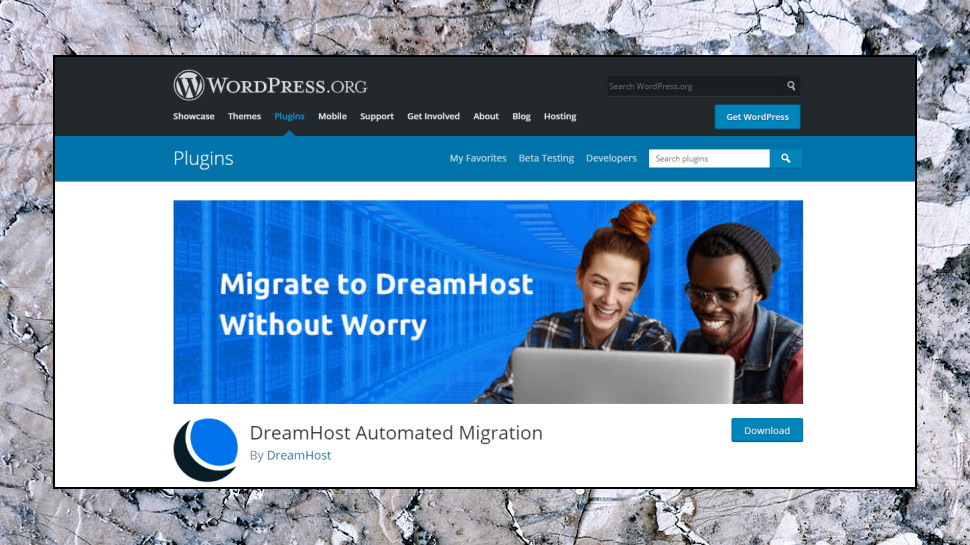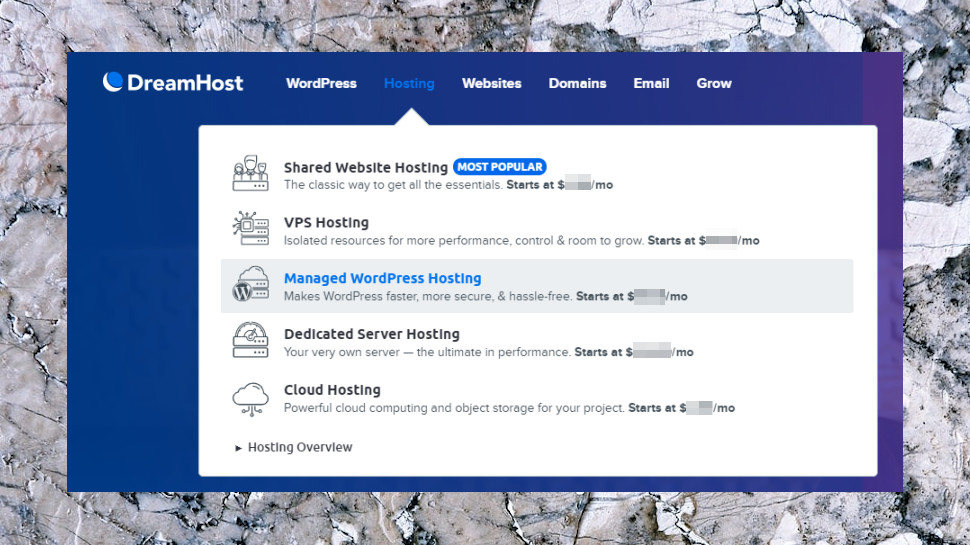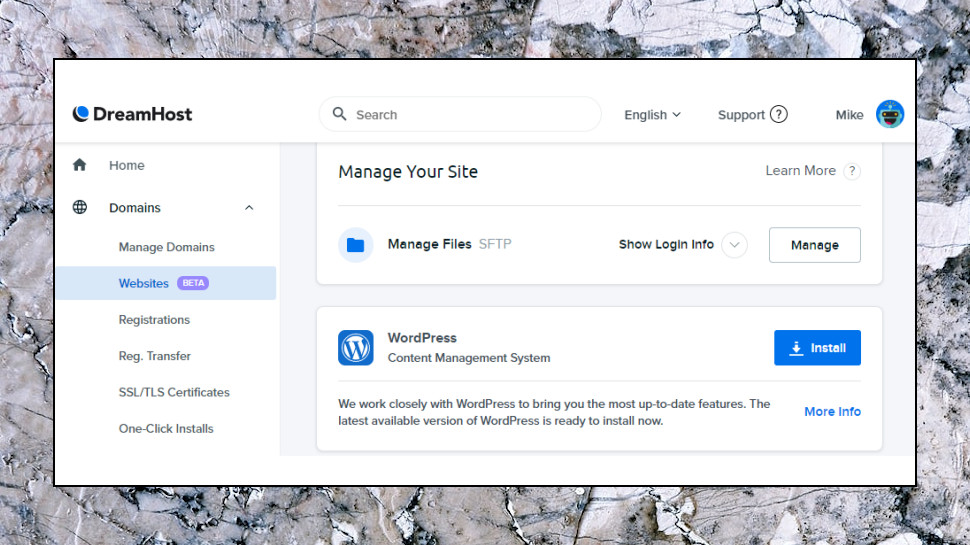DreamHost
After 20 years in the business you'd expect DreamHost to know what it's doing, and first impressions don't disappoint. The company offers shared, WordPress, cloud, VPS and dedicated web hosting with stacks of features and interesting options.
Shared hosting begins with the Starter plan which gets you 50GB storage, automated daily backups, unmetered bandwidth, free SSL, a free domain (with free domain privacy) and automated WordPress installation.

Using WordPress already? The company now provides a free DreamHost Automated Migration plugin to help import your site.
The plan also includes an optional WordPress Website Builder. This is powered by BoldGrid, and enabling the builder gets you access to BoldGrid's Premium tools and themes, something that would cost $5+ a month if you signed up with BoldGrid direct.
- Want to try DreamHost? Check out the website here
All this can be yours for an effective $2.59 a month over three years ($3.59 on the annual plan, $4.59 billed monthly.) That's the regular price, too, no introductory discount, so you won't get any nasty surprises on renewal.
Sounds good, but there's a big catch. The Starter plan doesn't come with any yourname@yourdomain.com email support, and adding just a single account costs from $1.67 a month, lifting the total to $4.26 a month.
If email is a must, upgrading to the Shared Unlimited plan gets you unmetered email addresses, domains, storage, bandwidth, subdomains, databases and more. This looks like much better value to us at $4.95 a month on the annual plan or $10.95 billed monthly. (Again, there are no special introductory deals here, so the costs aren't scheduled to double or more on renewal.)
DreamHost competes well with other big-name hosts. HostGator's similar Baby plan has unmetered domains and bandwidth, and is cheaper over three years at a headline $3.95 a month. But that's only due to the introductory discount: it renews at a far more expensive $9.95.
The company doesn't score in every area. There's no choice of data centers, for instance: it's US-only. And although support is available 24/7 via ticket, live chat is only available 5:30AM-9:30PM Pacific Time, and there's no telephone option.
If these aren't issues for you, though, DreamHost scores well for its value. The company offers an exceptional 97-day money-back guarantee, too, suggesting real confidence in its products and service.

WordPress
DreamHost excels at WordPress hosting, with shared, managed and other options, all available in multiple flavors.
Shared WordPress hosting is essentially DreamHost's regular shared plans. There's an option to pre-install WordPress and a template-based WordPress Website Builder, but otherwise it's just the company's shared hosting with a new name.
DreamHost's Managed WordPress accelerates performance with server-level caching, while automated WordPress updates ensure security patches are installed as soon as they appear, and daily and on-demand backups are thrown in.
Specialist WordPress features include easy-to-use staging. One click and you're able to create and work on a copy of your WordPress project, allowing you to try new themes, plugins or make other major changes without affecting your production site. It's a valuable extra, and not something you'll see in all WordPress hosting plans.
DreamPress Basic gets you all these features, 30GB storage and support for around 100,000 monthly visitors on a single site. It's priced from $16.95 a month on the annual plan, $19.95 monthly.
DreamPress Plus doubles your storage space, adds the Jetpack Professional plugin, unlimited CDN use and is built to handle 300,000 visitors a month. It's $24.95 a month paid annually, $29.95 paid per month.
DreamPress Pro adds more resources and can handle more than a million monthly visitors, but its real value could be the extra DreamCare support. The support team monitors your site, does more advanced troubleshooting, and fixes problems when they appear, rather than waiting for you to notice and report them. It's much more expensive at $71.95 a month billed annually, $79.95 billed monthly, but if you're running a business-critical site, it could easily be worth the extra.
These are a well-balanced set of plans with something for every level of user, and also compete well with most providers.
If you're looking to save a little cash, though, consider IONOS' WordPress Pro One plan. Storage is limited to 10GB, but it has a decent set of features - staging, automated updates, intelligent caching - and is just $18 billed monthly (no long-term contract required.)
If you need more power, Bluehost's Build plan offered unmetered storage and bandwidth, and supports hosting unlimited websites, for a very reasonable $19.95 on the three-year plan, $24.95 annually, renewing at $29.99.
Servers
Outgrown shared hosting? Upgrading to a Virtual Private Server (VPS) improves speeds by giving you your own server resources, which you'll never have to share with anyone.
DreamHost’s VPS Basic plan looks cheap at just $10 a month over three years, $13.75 on the annual plan, especially as it's a managed product (DreamHost maintains your server, upgrading the OS, installing security patches and so on.) Resources are basic at just 1GB RAM and 30GB storage, and, importantly, there are no guaranteed CPU resources, but the account has no limits on traffic, email addresses or the number of websites you can host.
There are several other plans, but picking just one, VPS Professional offers a more capable 4GB RAM and 120GB storage for $40 a month over three years, $55 paid annually.
These are decent value, but don't quite have as many options or configurability as the best of the competition.
For example, Hostwinds has up to ten baseline plans, rather than four; they're all available in Windows, as well as Linux flavors, and cheap unmanaged as well as easy-to-run managed types; and they're individually very configurable, with guaranteed CPU resources. Bandwidth is limited, but allowances are generous (at least 1TB a month), and prices start from $10.99 for a managed Linux plan.
DreamHost's wide range of dedicated server plans run from an ordinary Xeon 4-Core 8-Thread and 4GB model to an enterprise-level 12-Core 24-Thread 64GB setup.
They're not always as configurable as we'd like - forget Windows hosting, for instance - but the lengthy feature list includes uncapped bandwidth, PHP acceleration via OPcache, a custom control panel, unlimited IPv6 addresses, 24/7 server monitoring and tech support.
Pricing starts at a reasonable $149 a month on the annual plan, or $169 billed monthly (DreamHost doesn't punish you with a massive price hike for taking the short-term option, unlike some competitors.)

Signing up
The DreamHost website does a mostly decent job of explaining what is offered by each of its plans, and how much you're expected to pay.
The site still misses in some areas, though, for example stating that email accounts for budget shared hosting are 'available for purchase', but not giving any clue as to how much they cost, or pointing us to where we can find out.
DreamHost scores well for its overall price transparency, with the site enabling us to see monthly, one- and three-year prices on the main page, at a click. That's a major improvement on other hosts who might tell you a plan is '$5/month', but force you to click 'Buy' before you get to see the subscription length and the renewal price.
We began an order, and amongst the usual options (and a single email address costing $1.99 a month on the baseline shared hosting account) the site gave us the opportunity to preinstall WordPress and its WordPress Website Builder, for free.
Most web hosts provide some kind of automated WordPress installation feature, but there's no doubt that checking a box on the order form makes it even easier. We accepted both the WordPress and Website Builder options.
Payment is accepted via card and PayPal. We handed over our cash and the site directed us to DreamHost's web dashboard. Our account wasn't immediately activated, but the process only took a few minutes, and then we were ready to go.

Creating a site
DreamHost's capable web dashboard opens with a 'Build Website' panel which offers multiple ways to begin your web project.
A WordPress Editor option launches BoldGrid's excellent site builder. In a click or two you're able to choose a template site, begin editing the content, then configure it with your details (name, email address, social media links, and more.) Click Install, your template site is set up, and you're directed to the conventional WordPress dashboard, ready to manage the site as usual.
If you have a WordPress site already, or you're an experienced WordPress user and happy to build a site from scratch, you're able to bypass BoldGrid and log in and use WordPress directly.
DreamHost also provides one-click installs of concrete5, Joomla, MediaWiki, phpBB and Zen Cart. That's welcome, but it can't match platforms like Softaculous, offered by many hosts, which enables installing hundreds of top apps.
Elsewhere, although DreamHost doesn't bundle cPanel with its shared hosting, you're able to access similar features from its own custom control panel.
A file manager enables uploading an existing site or working with files installed by other applications.
This is based around Monsta, an excellent web-based FTP-based file manager, easy to use but with some surprise extras. (You don't just get to copy, rename or delete files, for instance - you can edit them in a full-screen editor with full syntax highlighting.)
There are further tools to manage email (if available with your plan), domains, MySQL databases, SSH, Cron Jobs and more.
It's a decent set of site management features, reasonably easy to use and with some welcome touches, such as the editor. We would still prefer cPanel, though, as it's even more capable and experienced wouldn't need to find their way around another interface.

Support
We're always keen to see how a web host's support system performs, and DreamHost's website got the company off to a good start. You can enter a keyword at any time in the control panel search box to pull up relevant articles, and a Help menu gives you links to all your web-based support options: knowledgebase, community forum, live chat and email.
The knowledgebase tramples all over most of the competition. Our ‘import WordPress’ search returned a large number of relevant articles, with clear opening summaries in the list of search hits. These were individually very helpful, with plenty of screen grabs and step-by-step guidance, and advice on dealing with potential problems (what to try if PHP times out during a lengthy upload, for example).
We also ran searches for single keywords like PHP, MySQL or Apache, which can give a more general feel for the depth of a knowledgebase and the way search results are ordered. There were a huge number of documents, mostly very helpful, and although some were short, that's usually because they point you to the best resources elsewhere (the official php.ini directives list at php.net, for instance).
Live chat is 'only' available 5:30AM-9:30PM Pacific Time, but support via ticket is available 24/7, and in our experience the team provides accurate and reliable help.

Performance
Shared hosting generally doesn't deliver great speeds, especially at the budget end of the market. Some providers can surprise you, though, so we were keen to see what DreamHost can do.
We began by signing up for DreamHost's most basic shared hosting package, then uploaded a very simple static website.
Next, we had Uptime.com monitor our site's availability and response times from multiple locations around the globe. Checks were made every five minutes over a seven-day period, totaling more than 2,000 individual samples.
Our site achieved 100% uptime, no outages at all. That's what we would expect to see in a short test, but it's still good news.
Response times averaged 274ms. Very broadly, other budget shared hosting products we've tested manage 200-400ms, so DreamHost is fractionally faster than average, but not by enough that you're likely to notice.
Our results were generally very consistent, too, with a range of 235-465ms. And although our one-week testing period is relatively short, our last review returned a similar 295-414ms, indicating this is the kind of result you can expect over the long term.
(Be careful how you interpret these results. They're comparing the server response times for basic shared hosting plans only, and don't give us any indication of page generation and load times, or tell us how cloud, VPS or dedicated plans might compare.)
Final verdict
DreamHost has some quality products and the prices are fair, but there are one or two unusual catches: no email with the starter shared hosting plan (it's a paid extra), no allocated CPU resources with VPS hosting. These won't matter to everyone, but check the small print carefully before you buy.
- Best overall web hosting services
- Best WordPress hosting providers
- Best cloud hosting providers
- Best Linux web hosting services
- Best e-commerce hosting
- Best dedicated server hosting
- Best small business web hosting
- Best Windows hosting services
- Best managed web hosting
- Best green web hosting
- Best business web hosting
- Best colocation hosting
- Best email hosting providers
- Best VPS hosting providers
- Best web hosting resellers
Comments
Post a Comment